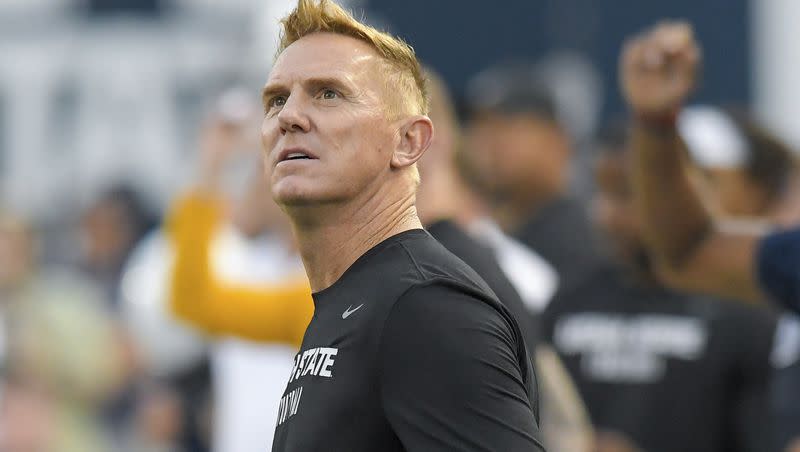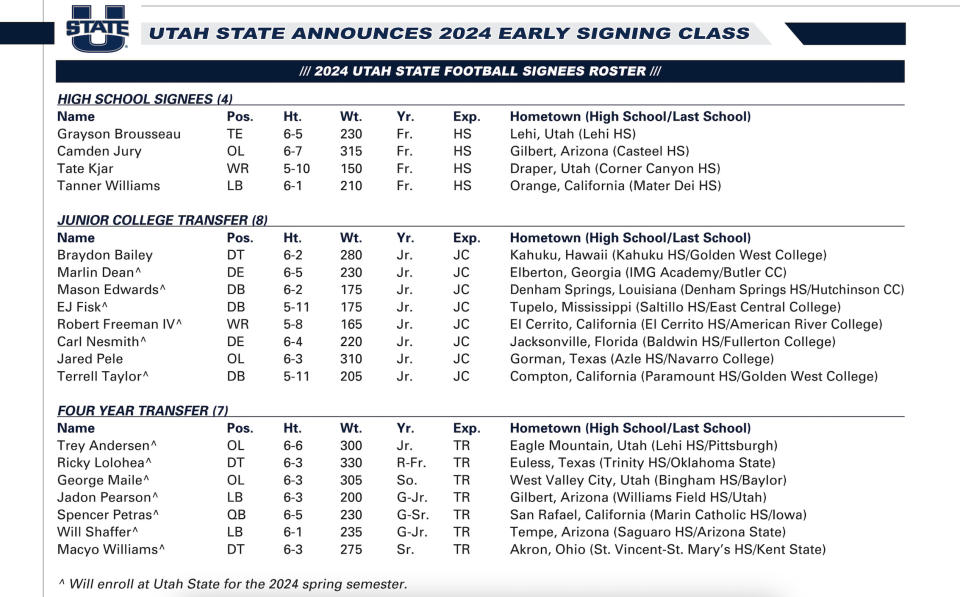Utah State addressed key needs with talented, well-rounded early signing class

With the exception of one last-minute flip, Utah State had a successful opening to the early signing period, per head coach Blake Anderson.
“I‘m not sure exactly how all this ranks in terms of all those different things,” Anderson said, “but just for us as a staff and as a head coach, I’m super pleased with how today went.”
“We addressed some significant needs on our roster. If you look at the bodies, what they’ve been able to do where they are coming from, in the juco ranks and the portal guys, most of them of these guys have the ability to come in and impact our team immediately.” — Utah State coach Blake Anderson
The Aggies officially signed 19 players Wednesday, a combination of high school prospects, junior college transfers and FBS transfers.
The Aggies’ high school class consisted of four players, including two Utahns.
USU also signed eight junior college transfers, in addition to seven FBS transfers, six of whom are coming from Power Five programs.
Thirteen of the 19 players signed will enroll in January.
Twelve of the signees are rated as at least a three-star recruit by one of the major recruiting services (247 Sports, Rivals, On3 Sports and ESPN) and two signees are rated four-star prospects.
The Aggies went heavy on defense, signing 11 players, including five defensive linemen, three defensive backs and three linebackers. Of the other eight signees, there are four offensive linemen, two receivers, a quarterback and a tight end.

“We addressed some significant needs on our roster,” Anderson said. “If you look at the bodies, what they’ve been able to do where they are coming from, in the juco ranks and the portal guys, most of them of these guys have the ability to come in and impact our team immediately.
“Most will be here in January, which is even better, to add value to (position) rooms and competition in rooms that will create possibilities for guys to get on the field and be either significant players or even starters at their position. And for us that was critical.”
Combined with the Aggies retaining all but one underclassman from their two-deep depth chart in December — safety Devin Dye was the lone Aggie starter to transfer — Anderson believes his team is in a position to get “a lot better in the next six months.”
“We think the recruiting process started, really, a couple months ago as we started recruiting our roster to stay put,” Anderson said. “And I think if you look at this, the recruiting class on its own it’s one thing, but in combination with the fact that we’ve only had one player out of our entire two-deep put his name in the portal and leave ... to me I think what really is a significant conversation is the fact that we have held on to our roster and now have added a very, very good class that has a chance to come in and make us a lot better.”
Why such a small high school class?
The Aggies only signed four high school prospects, namely Lehi High tight end Grayson Brousseau, Corner Canyon High receiver Tate Kjar, Mater Dei High (California) linebacker Tanner Williams and Casteel High (Arizona) offensive lineman Camden Jury.
Per Anderson, program construction, and with it recruiting, have been drastically altered by the transfer portal, necessitating the Aggies take more players who can contribute in meaningful ways earlier, rather than bring in players that could take years to develop.
“I just don’t think you can take the same old approach that we always did,” Anderson said. “You know, the ability to sign 25 high school guys and develop them over a five-year period, I don’t think it exists anymore, especially not for us.
“If we develop a guy too quickly, somebody’s gonna come come buy him. If you develop a guy too slowly, somebody else is going to be coaching him because they’re gonna run me out of town. We’ve got to be competitive yearly and we want to be. And the best way to do it is to balance using high school (prospects), juco and portal transfers to blend your roster on a yearly basis to be as competitive as you can.”
Specific to Brousseau and Kjar, Anderson noted that the Aggies saw them often and were impressed.
“They were no-brainers for us,” he said.
Brousseau, a two-sport athlete (basketball and football), was seen as a real positive and Kjar’s production for the top team in the state was difficult to look past.
Related
“Every time you turn around, he’s making a huge play,” Anderson said. “He had great camps with us, we love the family and just where he comes from and how he’s been trained. Those were easy decisions for us, great additions.”
Did the Aggies improve on the offensive and defensive lines?
During the season, Anderson noted time and again the need for his team to improve in the trenches, and he said repeatedly that part of improving would come with recruiting better players.
All told, USU signed nine linemen Wednesday, four on offense and five on defense.
They were needed signings and a step in the right direction, Anderson said.
“I do think we made some huge additions when you consider saying length, power, speed and twitch,” he said.
Specifically, the additions of Marlin Dean and CJ Nesmith give the Aggies a pair of pass rushers with real ability. Dean is a four-star recruit and former Georgia signee, while Nesmith is junior college All-American.
“We struggled with pass rush and I think we found two of the best pass rushers on the market,” Anderson said.
At defensive tackle, USU added three players in Braydon Bailey, Ricky Lolohea and Macyo “Taz” Williams that Anderson believes can shore up the interior of USU’s defense.
“We’ve struggled to hold point up front on the defensive line, especially inside, and Bailey and Ricky and Taz all have the ability to come in and help,” Anderson said.
On the offensive line, FBS transfers like Trey Andersen and George Maile have the ability to start immediately, though they weren’t promised starting jobs. Anderson expects that they have “the ability to come in and be on our two-deep from Day 1. And in fact, maybe make our roster as starters. And that makes us that much better.”
The next Deven Thompkins or Terrell Vaughn?
Utah State did not go heavy in signing skill position players, adding just three, two of whom are aforementioned high school prospects.
The other is junior college transfer receiver Robert Freeman IV, an All-American wideout and kick returner who Anderson believes can be the next Aggie standout a la Deven Thompkins and Terrell Vaughn.
“He fits the mold of what we’ve seen with DT and Terrell,” Anderson said. “. ... The guy literally did not come off the field (for American River College) except for defense. He played on basically every special teams and offensive snap. He was the most dynamic player in person, but also one of the most dynamic players on tape and a great dude.
“We absolutely loved his personality when he came in on his visit. And those guys (former American River College standouts turned Aggies Cian and Teeg Slone) just raved about how hard he worked, what kind of teammate he was and how much he loved the ball. It made a lot of sense to us.”
Listed at 5-foot-8, Anderson noted that he wasn’t quite sure how much attention from other teams Freeman received, but that the Aggies have had a way with smaller playmaking receivers.
“We’ve seen a lot of success with those really dynamic, maybe smaller guys and he fits the mold and can be just as good as the ones we’ve had,” Anderson said.
A special junior college class
The Aggies added more junior college players than either high school prospects or FBS transfers and per Anderson it is the most talented group of junior college players Utah State had added during the last four years.
“I think it is our best junior college class, when you look at just how heavily recruited some of these guys were and what kind of impact they can make,” Anderson said.
He went on to note that several of the Aggies’ junior college signees were offered significant NIL deals elsewhere, but due to USU recruiting the junior college ranks early and often this season, Utah State won out in the end.
“Several of these guys were being offered six figure opportunities to flip from us and go to other places,” Anderson said. “Those guys held out and I think it is because of our approach and the relationships that we built.
“I felt like we were able to hang on to some quite high-quality players out of the juco ranks that had we not taken this approach we’d have missed on.”
The Aggies also added junior college signees in defensive backs Mason Edward, EJ Fisk and Terrell Taylor, along with offensive lineman Jared Pele.
The group in totality includes multiple All-Americans, on both offense and defense.

